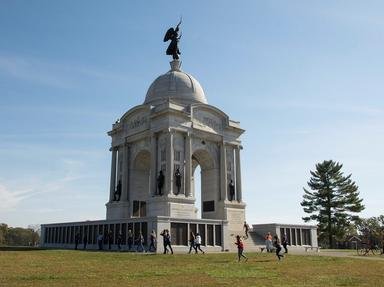Quiz Answer Key and Fun Facts
1. Which Confederate officer served as Gen. Robert E. Lee's Chief of Staff during the Battle of Gettysburg?
2. Which Confederate officer commanded a brigade from Louisiana that was known by the nickname "Louisiana Tigers"?
3. Which Confederate officer resigned from the U.S. Military Academy at West Point due to poor grades compounded by the fact the he also struck a fellow cadet that he would later serve with in the Army of Northern Virginia?
4. Often sick during the Civil War, Confederate 3rd corps commander Gen. Ambrose Powell Hill was ill during the Battle of Gettysburg and saw only slight action. What illness is it commonly believed that Hill suffered from at Gettysburg?
5. Gen. Richard Kemper was captured twice by Union troops at Gettysburg on 2 separate days.
6. Which officer served as Chief of Artillery for the Army of Northern Virginia during the battle of Gettysburg?
7. Which Confederate commander was the first to encounter Union troops in Gettysburg?
8. Which Confederate officer rode into battle on at Gettysburg and was never seen again, dead or alive?
9. During the Confederate assaualt on July 3, 1863 known as "Pickett's Charge", gen Lewis Armistead is known to have hollered to his men, Come on boys! Give them __________"
10. Which Confederate officer's life was spared by a newspaper during the battle of Gettysburg?
11. Which Confederate officer led his troops, penetrating the Union line of defense on Cemetary Ridge farther than any other commander during the Battle of Gettysburg?
12. Which Confederate commander was attacking Cemetary Hill on the evening of July 2, 1863, when he was shot from his horse, falling partially paralyzed onto the ground unoticed by his troops?
13. Gen. Isaac Trimble, who commanded a division during "Pickett's Charge", resigned his command under Gen. Richard Ewell due to a falling out with his Ewell.
14. Gen. James Longstreet never gave a verbal command to commence the Confederate attack on July 3, 1863 known as "Pickett's Charge".
15. Which Confederate commander was shot in the left leg on July 1, 1863 and still continued to command throughout the Battle of Gettysburg without being treated?
16. Gen. Robert E. Lee was known to prefer to ride his famous horse, "Traveller". However, Lee travelled with two horses. What was the name of his other horse?
17. Not arriving in Gettysburg until the early afternoon on July 2, 1863, Confederate cavalry commander Gen. "Jeb" Stuart did not command troops in the Battle of Gettysburg.
18. Which Confederate officer holds the distinction of being the first infantry officer with the rank of general to be captured by Union troops since Gen. Robert E. Lee took command of the Army of Northern Virginia in 1862?
19. Gen. Robert E. Lee commonly referred to which Confederate officer by his first name or his nick-name?
20. According to Confederate statistics, which Confederate corps commander had the most soldiers under his command during the Battle of Gettysburg?
Source: Author
Snorf1124
This quiz was reviewed by FunTrivia editor
bloomsby before going online.
Any errors found in FunTrivia content are routinely corrected through our feedback system.


